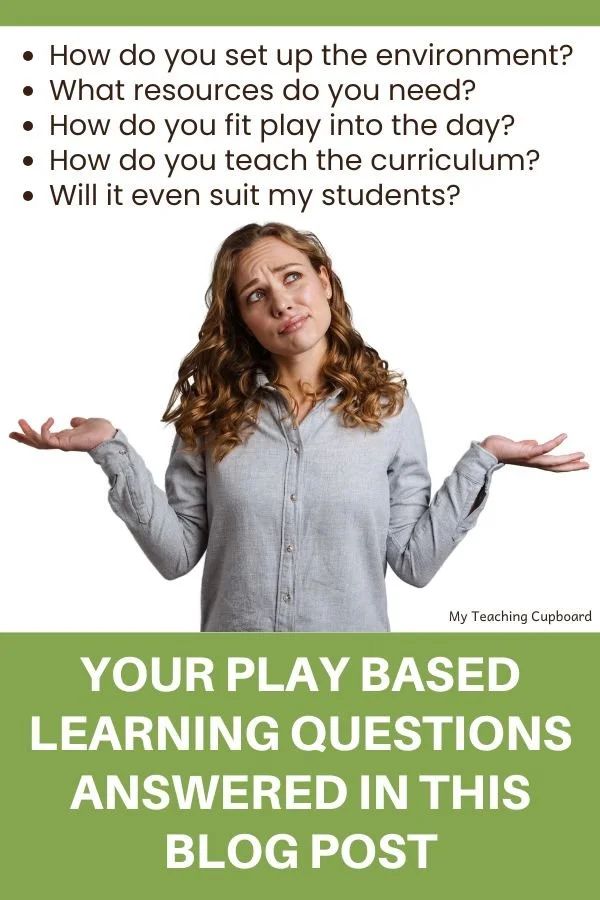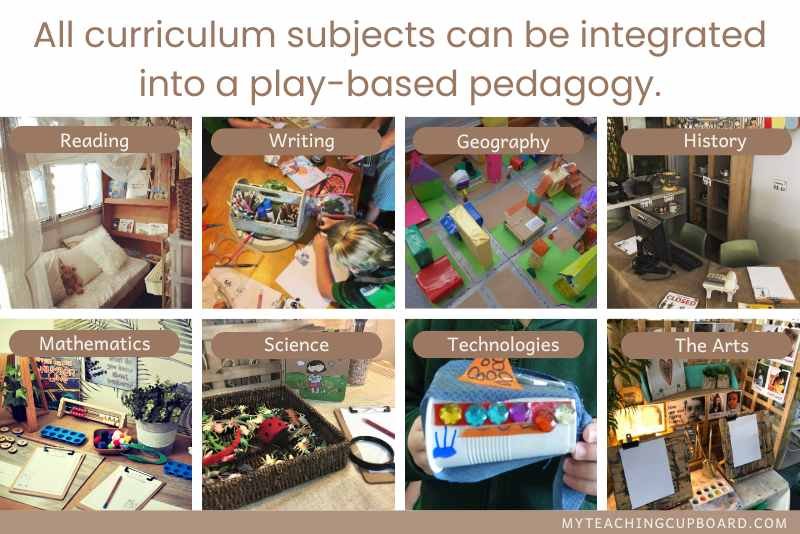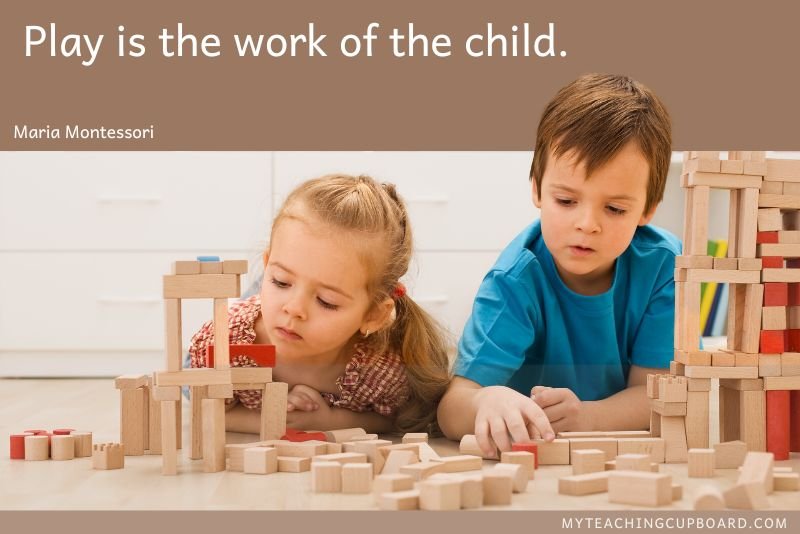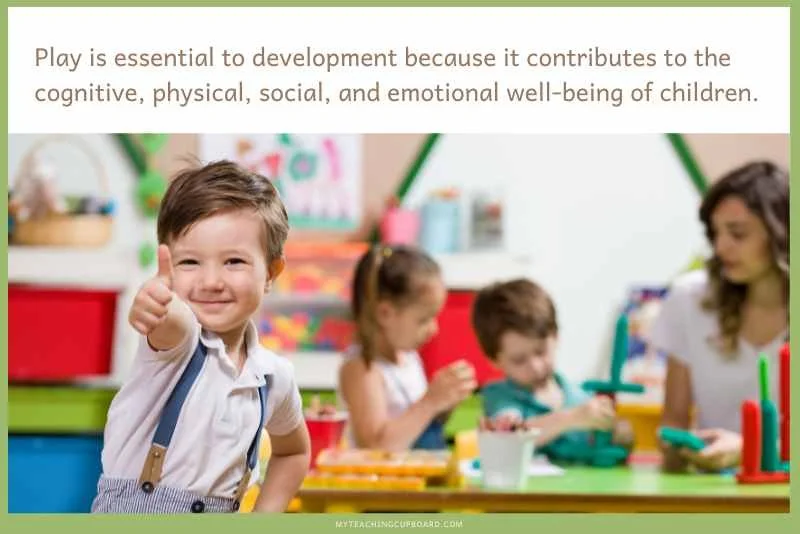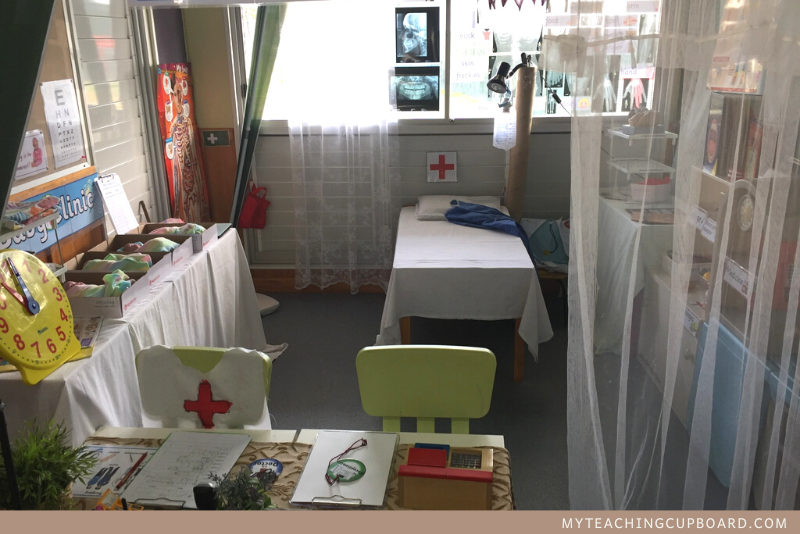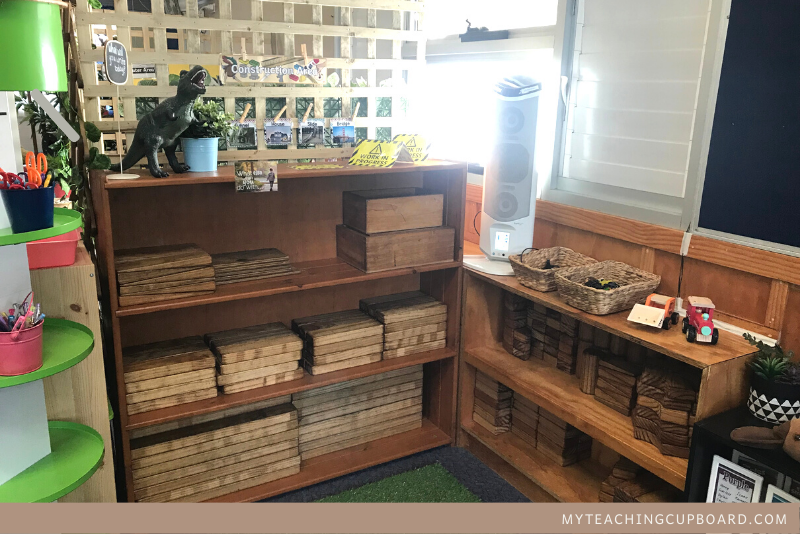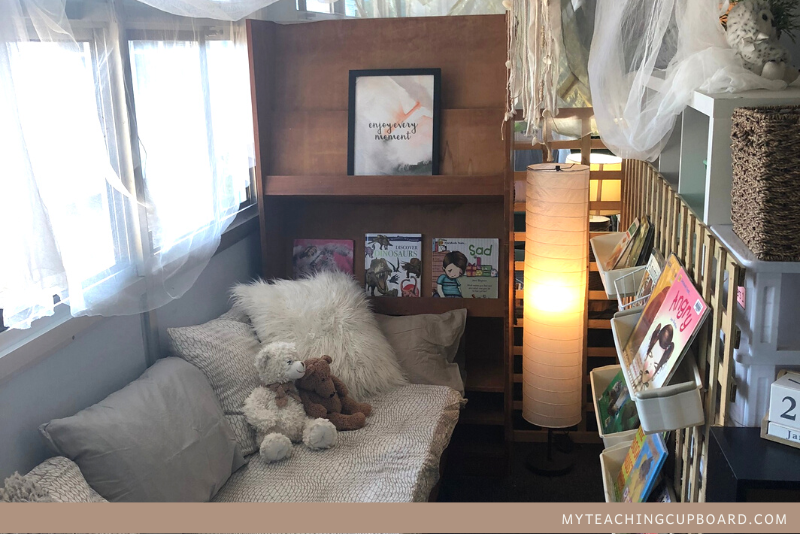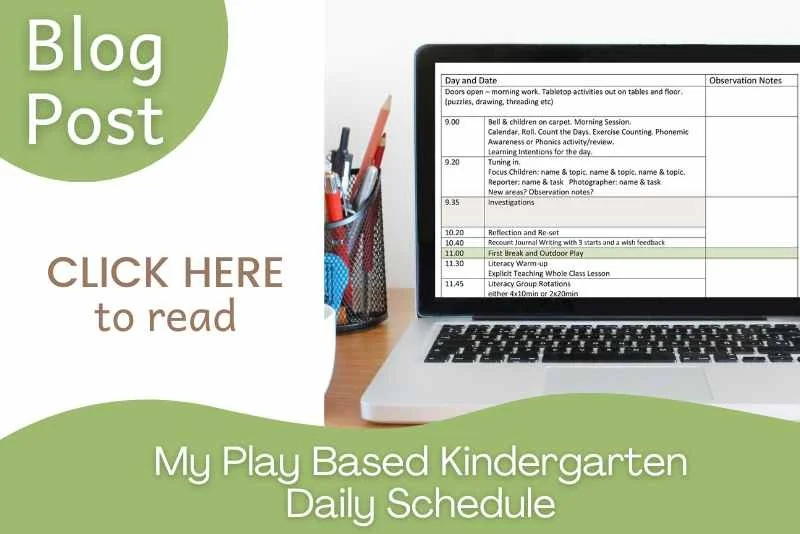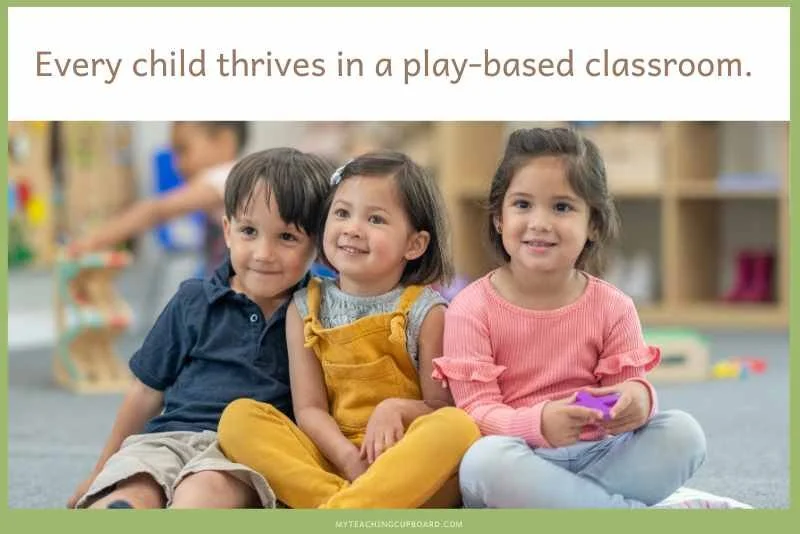Discover Play-based Learning Strategies for Prep or Foundation Stage
Discover essential play-based learning strategies for Prep or Foundation stage classrooms. Learn how to foster curiosity, meet curriculum goals, and create engaging play-rich environments with my tips and free guide.
Every day I walk into a classroom where my students are actively exploring, questioning, and building their knowledge through play. If this sounds like the kind of learning environment you want to create—keep reading!
For many educators, implementing play-based learning can feel overwhelming.
How do you set up the environment?
What resources do you need?
How do you fit play into the day?
How do you balance the curriculum demands in a play based classroom?
Will play based learning even suit my students?
These are the questions I get asked a lot and are the same ones I asked myself when I first started my play based learning journey.
The truth is, not only is it possible to create a rich, play-based environment that engages and benefits all students, but it’s also one of the most effective ways I’ve found to meet all those mandated curriculum goals.
In this blog post, you’ll discover essential strategies for bringing intentional play-based learning into your Prep, Kindergarten or Foundation Stage classroom.
These strategies will help you design purposeful and age appropriate learning experiences that spark curiosity, keep your young children deeply engaged, and ensure they develop the curriculum skills and knowledge they need (and then some!)
What is Play-Based Learning?
At its heart, play-based learning is a child-centred approach to education that taps into children’s natural curiosity and desire to explore. Rather than relying solely on structured, teacher-led instruction, this method encourages students to learn through play—whether it’s building with blocks, engaging in dramatic role-play, or investigating the natural world.
Definition and Core Principles
Play-based learning is built on the idea that children learn best when they are actively engaged in activities that interest them. It focuses on creating meaningful, hands-on experiences that:
Foster active engagement: Children take an active role in their learning, experimenting and discovering as they go.
Encourage exploration: The process of play allows children to ask questions, test ideas, and explore new concepts at their own pace and at their developmental level.
Promote social interaction: Play is inherently collaborative, helping children build relationships, communicate effectively, and solve problems together.
Through this approach, educators create an environment where play is not just a break from learning—it is learning.
Benefits for Young Learners
The benefits of play-based learning extend far beyond keeping children entertained. When play is used as the foundation for learning, it supports:
Cognitive development: Through play, children build problem-solving skills, develop critical thinking, and improve memory and concentration.
Creativity and imagination: Open-ended play allows children to think outside the box. It nurtures innovation and self-expression.
Social skills: Interactive play encourages communication, sharing, negotiation, and empathy and lays the groundwork for a positive classroom community.
Emotional well-being: Play provides a safe space for children to express their feelings, manage stress, and build confidence.
To learn more about the numerous benefits of play-based learning and the importance of play for young students, check out my blog post: Benefits of Play-Based Learning in Early Education.
By focusing on play, you will create a dynamic and engaging classroom environment that not only supports academic success but also nurtures the whole child.
Why Choose Play-Based Learning?
Some people think play-based learning is just a free play fun approach to teaching—something you do on the side if you have a bit of free time.
Actually it’s an incredibly effective way to
engage students
develop essential social-emotional skills
teach the mandated curriculum and lay a solid academic foundation.
Here’s why this teaching strategy is worth incorporating into your Prep, Kindergarten, or Foundation Stage classroom.
Play is Highly Engaging and Keeps Students Focused
One of the standout benefits of play-based learning is how naturally it captures students’ attention and focus. Unlike traditional methods where children passively receive information, play actively involves them in their learning. This intrinsic motivation keeps children engaged, curious, and eager to explore concepts further.
Play Enhances Social and Emotional Development
Play is inherently social. Whether children are role-playing in a dramatic play corner or working together to build a block tower, they are constantly developing essential social and emotional skills.
Through play, children learn to:
Communicate effectively and practice oral language skills.
Share resources and resolve conflicts.
Develop empathy by understanding others’ perspectives.
The focus on oral language development was one of the key reasons I adopted the Walker Learning approach in my classroom. Walker Learning, a play-based pedagogy, highlights the critical role of oral language in forming strong social connections and academic success.
It’s backed by research too! Oral language development is the foundation of literacy and essential for future academic achievement (Snow et al., 1998).
In my classroom, I’ve seen how all the opportunities for conversation and interaction during play have dramatically increased my students’ confidence and communication skills.
Building a Strong Academic Foundation
Play-based learning doesn’t just enhance social and emotional skills. It also develops foundational academic concepts and it does it seamlessly.
For example:
Literacy: Children develop pre-reading and writing skills through activities like storytelling, drawing, and dramatic play.
Numeracy: Counting, measuring, and recognising patterns naturally happen during activities like block play, sensory play and loose parts play.
Science and Inquiry: Play fosters curiosity and experimentation, introducing children to basic scientific concepts through hands-on investigations.
What makes play-based learning truly remarkable is its flexibility.
All curriculum subjects can be integrated into a play-based pedagogy, making it a comprehensive and engaging approach to meeting mandated curriculum goals and academic standards.
Play Based Learning and the Latest Research
Educational theorists like Maria Montessori emphasise the importance of self-directed, hands-on learning experiences.
"Play is the work of the child." – Maria Montessori
This quote emphasises Montessori’s belief that children learn best through hands-on, self-directed activities – these are key elements of play-based learning.
Montessori’s educational philosophy is rooted in the idea that children are naturally curious and capable of directing their own learning when provided with the right environment and materials. Play-based learning echoes this principle, offering open-ended activities that promote exploration and discovery, which are central to play-based pedagogy.
Research also shows that when children are engaged in play, their brain’s neural pathways associated with memory, problem-solving, and creativity are strengthened, leading to deeper learning.
A study by Adele Diamond and Kathleen Lee (2011) on executive functions highlights how play improves cognitive flexibility, working memory, and inhibitory control—skills crucial for problem-solving and academic success.
Another report on The Power of Play states play promotes the social-emotional, cognitive, language, and self-regulation skills that build executive function and a prosocial brain in children.
A study on Block Play and Pretend Play in Early Childhood Development found positive effects including improved development of language and communication skills, problem-solving abilities, social skills, and emotional regulation abilities. In addition, research indicates that children who engage in block play later demonstrate superior academic achievement.
"Play is essential to development because it contributes to the cognitive, physical, social, and emotional well-being of children and youth." – American Academy of Pediatrics (2007)
There are many reasons to choose play-based strategies in your classroom. Beyond the enhanced cognitive benefits of play and its ability to create meaningful, lasting learning experiences, play also fosters a love for discovery that extends well beyond the classroom.
Yes, your students will still meet academic benchmarks AND they will become independent thinkers, confident communicators, and lifelong learners. Play is a powerful tool!
Creating a Play-Rich Environment
A thoughtfully designed play-based environment is crucial for fostering exploration, creativity, and collaboration.
When children enter a space tailored to their needs and interests, their natural curiosity takes over. A carefully created environment ensures deeper learning and engagement. So let’s explore how you can create a dynamic, play-rich environment that meets your curriculum goals and supports every child’s development.
Setting Up Engaging Play Areas
Designing diverse, engaging play zones in your classroom ensures that all children have access to meaningful learning experiences. Each area should encourage exploration, inspire creativity, and align with your curriculum goals.
Here are some key areas to include:
Dramatic Play Corner: Stock this space with props for role-play and imaginative play. This area builds oral language skills, fosters creativity, and enhances social-emotional learning. You can add costumes, themed objects (like a doctor’s kit or a post office setup), and environmental print.
Block Play Area: Provide wooden blocks, loose parts, and construction sets to promote problem-solving, spatial awareness, and teamwork. Try to keep the area large enough for group collaboration.
Sensory Table: Use materials like playdough, water, sand, or rice to encourage sensory exploration. This space is ideal for developing fine motor skills and introducing early math and science concepts.
Art and Makerspace: Offer a mix of traditional art materials (paints, crayons) and recycled items for box construction and collage. This open-ended space invites children’s creativity and expressive languages.
Reading Nook: A cozy corner with books and soft seating creates a calm, inviting space to encourage a love of literacy. You can even add props or thematic books to this area that align with current curriculum investigations.
For detailed tips and ideas on setting up these and other classroom play spaces, visit my blog post: Creating an Effective Play-Based Learning Environment.
Essential Materials to Include in a Play-based Environment
To maximise the potential of each area, stock your classroom with versatile, open-ended materials that spark curiosity. Here are some must-haves:
Loose Parts: Items like buttons, shells, sticks, and beads to encourage creative thinking and problem-solving.
Sensory Materials: Provide items like playdough, sand, water, and tactile objects for hands-on exploration.
Art Supplies: Keep paints, markers, glue, scissors, and a variety of paper types easily accessible.
Literacy Tools: Include related texts, environmental print, clipboards, alphabet cards, magnetic letters, and themed props to support early reading and writing.
STEM Resources: Add items like building kits, magnifying glasses, and measuring tools for science and engineering activities.
For ready-made resources to simplify your setup, check out my Investigations Resources. These resources are designed to save you time and provide you with engaging printables suitable for effective play-based learning.
Incorporating Play into Daily Classroom Routines
Integrating play into your daily classroom schedule ensures students experience the benefits of play-based learning while also meeting curriculum goals.
With thoughtful planning, play becomes an essential part of your day because you have planned for it to enhance engagement and support deeper learning.
5 Ideas for Integrating Play into the School Day
Morning Meetings: Begin the day with a playful start! Use a quick circle game, a group rhyme, or a fun brainstorming activity to energise your students and set a positive tone for the day. This is also the perfect time to introduce the day’s learning intentions and connect them to your play based investigation areas.
Learning Centres During Group Rotations: Set up hands-on learning centres where children can rotate through activities linked to curriculum goals. For example, a math centre with counting games or a literacy station with magnetic letters for spelling.
Daily Investigation Sessions: Dedicate 45 minutes to purposeful play where children can explore themed provocations or investigation areas every single school day. Yes! This is possible and highly recommended! These activities are teacher-designed but child-led, allowing students to explore topics of interest while applying academic concepts naturally.
Story Time: Add an element of play by using puppets, props, or sound effects during storytelling sessions. These ideas will make your stories and read-alouds more engaging and also enhance language and listening skills.
Outdoor Play at Lunch Breaks: Extend learning outside by setting up simple outdoor play invitations. Activities like nature hunts, water play, or loose parts construction will all provide opportunities for hands-on exploration and social interaction during recess.
Balancing Structured Lessons with Play-Based Activities
In a play-based classroom, structured lessons and child-led play don’t compete—they complement each other. Striking the right balance is the secret to ensuring your students meet curriculum objectives while remaining engaged and motivated.
Teacher-Led Play: Use structured play sessions to introduce and reinforce academic concepts. For example, a math lesson on shapes could transition into a loose parts activity where students create patterns and shapes using blocks, sticks or pebbles.
Child-Led Play: Give students time to explore freely within your investigation areas. This encourages creativity, problem-solving, and social development as they make their own discoveries.
Play-based learning sessions don’t operate in isolation.
They need to be thoughtfully and purposefully designed to extend and deepen students’ understanding of concepts – usually those introduced during explicit teaching lessons.
As mentioned in my post, How to Start with Play-Based Learning, integrating play into your daily routine will help you link structured learning with hands-on exploration.
So, if you like the idea of play-based learning but just don’t know how to start, check out this blog post to discover some practical play-based learning examples you can use in your classroom and also get some tips on how you can easily get started with learning through play in your classroom today.
Examples of Effective Play-Based Activities
Meaningful, engaging play-based activities are the glue that holds everything together. From essential investigation areas to group rotations and STEM activities, here are some ideas to inspire your classroom setup and planning.
My 10 Best Play-Based Investigation Areas
These 10 must-have classroom areas ensure your students will have a rich and varied environment for exploration, collaboration, and learning:
Carpet Space and Meeting Area: A large, central space for circle games, discussions, and tuning-in sessions. This area is versatile and serves as a hub for class gatherings and interactive lessons.
Block Construction Area: Wooden blocks and loose parts provide endless opportunities for problem-solving, spatial awareness, and collaboration.
Dramatic Play Corner: Role-playing with props in this area builds oral language, creativity, and social skills.
Writing Table: A literacy center stocked with writing tools, journals, and manipulatives like magnetic letters for independent writing and exploration.
Reading Nook: A cozy space with books and soft seating to encourage a love of reading and quiet reflection.
Science and Nature Table: An interest-based area featuring natural collections, living things, and scientific tools for observation and inquiry.
Art & Collage Area: Open-ended art materials like paints, recycled items, and collage supplies can be found in this area. It develops literacy, creativity and fine motor skills.
Maths Area: A dedicated space for manipulatives, counters, and math provocations to practice foundational mathematical concepts.
Tinkering Station: A small space for building and deconstructing with real tools, nuts, bolts, and things like small engineering kits.
Sensory Play Area: Trays with sand, water, rice, or playdough support sensory exploration, self-regulation and fine motor development.
For detailed tips on setting up these spaces and some inspirational photos of my areas, visit my blog post: The 10 Essential Areas of A Play-Based Classroom.
Hands-On Games and STEM Activities
Incorporate group STEM and STEAM activities to build teamwork, problem-solving, and language skills. You can easily target integrated curriculum objectives through STEM education too. Here are some examples:
Build a Marble Run:
Objective: Design and construct a functional marble run using recycled materials like cardboard tubes, tape, and boxes.
Skills: Encourages problem-solving, engineering design, and trial-and-error experimentation.
Integration: Incorporates math (measuring distances), science (gravity and motion), and art (design and creativity).
Floating Boat Challenge:
Objective: Create a boat using various materials (foil, paper, straws) and test how much weight it can hold before sinking.
Skills: Introduces engineering concepts like buoyancy and design iteration.
Integration: Explores scientific principles while involving measurement (weight and volume).
Build a Wind-Powered Vehicle:
Objective: Use craft materials (paper, straws, wheels) to design a vehicle powered by wind (e.g., a fan or blowing).
Skills: Encourages creativity and understanding of wind energy and propulsion.
Integration: Combines physics (force and motion), engineering, and technology.
Design a Bridge:
Objective: Use materials like toothpicks, craft sticks, or LEGO to construct a bridge that can support a specified weight.
Skills: Teaches structural engineering and problem-solving.
Integration: Links to science (forces), math (geometry), and engineering.
Create a Shadow Puppet Play:
Objective: Make shadow puppets and explore how light and angles create shadows of different shapes and sizes.
Skills: Introduces concepts of light and shadow, encourages storytelling, and integrates the arts.
Integration: Combines physics (light), engineering (puppet mechanisms), and art (performance design).
DIY Catapult:
Objective: Build a working catapult using simple materials like popsicle sticks, rubber bands, and a spoon.
Skills: Explores force, trajectory, and engineering design.
Integration: Links to physics and math (angles and distance).
These activities are not only engaging but also integrate math, science, art and language objectives seamlessly.
Group Rotations
Structured group rotations provide opportunities for differentiated learning while also providing you the chance to offer both teacher-led direct instruction and independent activities.
Here’s how I organise my group rotations effectively:
Teacher-Led Group: I work with one group for explicit teaching, tailoring the lessons to the group’s ability level. For example, I might focus on letter recognition with one group and sentence writing with another.
Teacher Aide-Supported Group: I often have a teacher aide but not always. They facilitate guided activities, like collaborative projects or structured literacy and numeracy activities.
Independent Small Groups: The other groups are doing hands-on activities at play-based learning stations (sometimes investigation areas but usually specifically designed learning centers). These might include painting sight words or spelling words, a math game, or working on a curriculum aligned sensory activity.
This rotation model ensures students receive targeted instruction while also enjoying the autonomy and creativity of play-based exploration.
If you are interested in more details on how I run our literacy and numeracy group rotations, check out this blog post: My Play Based Kindergarten Daily Schedule
By incorporating these examples of play-based activities into your daily routine, you’ll create an effective and dynamic learning environment where your children are excited to explore, collaborate, and learn through play.
Linking Playful Learning to Curriculum Standards
One of the most powerful aspects of play-based learning is its ability to meet the curriculum standards of early childhood education while engaging children in meaningful, joyful exploration - all at the same time!
When activities are thoughtfully designed, they can seamlessly integrate learning objectives from the ACARA Curriculum, helping children develop foundational skills across literacy, math, science, and other areas.
Aligning Play-based Learning Activities with ACARA Content Descriptors
By planning intentional play-based activities, you can ensure your students meet mandated curriculum goals and also develop their creativity, problem-solving, and collaboration skills. Here are some examples:
Literacy Content Descriptor Example (AC9EFLY06): Students create and participate in shared editing of short written texts to record and report ideas and events using some learnt vocabulary, basic sentence boundary punctuation and spelling some consonant–vowel–consonant words correctly.
Play-Based Connection: Set up a dramatic play corner as a post office. Provide props such as envelopes, stamps, and letter-writing materials. Children can create letters and role-play mailing and delivering them. This activity builds oral language, writing skills, and comprehension.
Math Content Descriptor Example (AC9MFA01): Students recognise, copy and continue repeating patterns represented in different ways.
Play-Based Connection: Use loose parts like buttons, beads, or leaves at a math centre. Invite children to create patterns and describe their reasoning. Add recording sheets or digital documentation to assess their understanding.
Science Content Descriptor Example (AC9SFU01): Students observe external features of plants and animals and describe ways they can be grouped based on these features.
Play-Based Connection: Set up a nature-themed sensory tray with items like leaves, flowers, pinecones, toy animals, and magnifying glasses. Encourage children to group the items by features, such as plants with soft leaves or animals with fur. Include clipboards and drawing tools so children can document their observations. This activity nurtures observation skills, classification abilities, and an understanding of biodiversity.
Each of these examples connects directly to curriculum descriptors, ensuring that play-based learning remains purposeful and curriculum-aligned.
Documenting and Assessing Play-Based Learning Outcomes
Assessment in a play-based classroom looks different from traditional methods. It focuses more on observation and documentation to capture student learning.
Here are some effective strategies I use in my classroom:
Photo Evidence: Take photos of children engaged in activities that demonstrate learning. For instance, take a picture of a student building a tower in the block area to show their understanding of balance and spatial reasoning. Pair the photo with a brief note about the activity's learning objective.
Anecdotal Notes: Record observations of individual children or groups during play. Note what they are doing, saying, and how they are interacting. These notes help you to track progress over time and identify areas needing further support.
FREE Observation Checklist: Use my downloadable Observation Checklist to document learning outcomes easily. This tool helps you track curriculum-related skills and behaviours and will make assessments in your play-based classroom manageable and organised.
Student Work Samples: Collect physical or digital samples of children’s creations. Think about creating a portfolio of drawings, written work, or even audio recordings of their reflections during investigations.
Why Documentation Matters
Not only does documenting learning help you assess progress, but it also provides valuable insights for planning future activities and communicating with parents. These records demonstrate how play-based learning supports curriculum goals in the early years and can give you some powerful evidence of its impact.
By aligning play with curriculum standards and leveraging thoughtful assessment strategies, you can easily create a classroom where play-based learning is both joyful and academically rigorous.
Don’t forget to download the FREE Observation Checklist to streamline your assessment process!
Overcoming Challenges in Play-Based Learning
Implementing play-based learning can sometimes feel overwhelming, especially when faced with misconceptions or the diverse needs of so many of our young learners.
By addressing these common concerns and tailoring strategies to support all your students, you can say goodbye to overwhelm and hello to both an effective and inclusive pedagogy.
Addressing Common Concerns and Misconceptions
A frequent misconception about play-based learning is that it’s unstructured or a free-for-all. 🙄
In reality, high-quality play-based learning is intentional, thoughtfully planned, and deeply connected to educational outcomes and academic skills.
Effective Play Based Learning Has a Structure: While play may look spontaneous, it is guided by clear learning objectives. Educators design provocations, ask open-ended questions, and use their observations of play to extend learning and scaffold new concepts.
Research Backed Evidence of Effectiveness: Research consistently shows the benefits and effectiveness of play-based learning - both on academic and social outcomes.
The American Academy of Pediatrics highlights that play contributes to cognitive, physical, social, and emotional well-being in children.
A longitudinal study by Pyle and Danniels (2016) found that children in play-based programs demonstrated stronger language skills, problem-solving abilities, and social competence compared to peers in more traditional programs.
By understanding and communicating the structure and purpose of play-based learning, we can shift the narrative from just play to a proven, effective teaching approach that supports whole-child development.
Strategies for Managing Diverse Learning Needs
One of the greatest strengths of play-based learning is its flexibility. This teaching approach really does allow educators to tailor activities that meet the diverse needs, interests, and developmental stages of their students.
Here’s some strategies to help you:
Differentiate Activities:
Use open-ended materials, such as loose parts or building blocks, that can be adapted to varying levels of complexity. For example, younger children may build simple towers, while older or more advanced learners might construct intricate structures and explain their designs.
Offer choice and voice in learning by providing multiple play options, catering to different interests and abilities.
The Zone of Proximal Development (ZPD):
Play-based learning naturally supports Vygotsky’s concept of the ZPD, where children learn best when activities are slightly beyond their current ability but achievable with guidance.
During block play, for example, a teacher might scaffold a child’s learning by introducing vocabulary like balance or symmetry to further develop their vocabulary and their building skills.
Building Autonomy and Self-Esteem:
Play-based learning allows children to take ownership of their learning, which boosts autonomy and confidence.
Unlike rigid tasks with a right or wrong answer, open-ended play ensures every child feels successful and that in turn will reinforce positive attitudes toward learning.
Protecting Children from Unrealistic Expectations:
It’s disheartening to see children begin their first year of schooling excited and enthusiastic, only to end the year feeling like failures due to an overly rigid assessment and reporting framework.
Play-based learning mitigates this by meeting children where they are. It provides students with opportunities for authentic success and growth at their own pace. It gives permission for children to work at their own developmental level and not some assumed unrealistic curriculum level.
Why Supporting Diverse Needs Matters
When play-based learning is implemented thoughtfully, it creates an inclusive environment where every child feels valued and capable.
Children are given the time and space to explore, develop at their own pace, and build skills that will serve them throughout their lives. By addressing concerns, advocating for play-based learning, and designing flexible, developmentally appropriate experiences, we can ensure no child is left behind—and that the joy of learning remains intact.
By embracing the challenges and leaning into the strengths of a play-based pedagogy, we can create classrooms where every child thrives!
Personal Anecdotes from the Classroom
Stories from the classroom often provide the clearest evidence of the power of play-based learning. These real-life moments from my play-based classroom highlight how play can unlock potential, spark creativity, and build essential skills.
Real-Life Success Stories
The Post Office Transformation: One year, I set up a dramatic play post office. It had envelopes, play stamps, a mailbox, and a delivery bag. A student who had struggled with oral language skills connected with this area and enthusiastically took on the role of Postmaster. He wrote letters, organised the class mail, and delivered it to classmates. By the end of the term, his confidence had soared, and his speaking and writing skills had noticeably improved.
Collaborative Block Play Masterpiece:
During an investigation session, a group of children decided to build a city at the Makerspace. They worked together to design roads, bridges, and buildings. This activity tied in perfectly with the HASS unit on our local area. I observed the students solving problems like wrapping boxes and measuring materials. Watching them collaborate, negotiate roles, and explain their ideas was a powerful reminder of how play fosters teamwork and critical thinking.
Curiosity Sparked by Nature:
When a student brought in a bird feather she had found, it inspired an impromptu exploration at our science and nature table. We examined the feather under a magnifying glass and compared it to other items, like the leaves and pinecones already at our nature table. The activity led to a discussion about animal features and was the springboard into a broader investigation into birds and habitats.
Lessons Learned and Tips for Teachers
Follow the Child’s Lead: Play-based learning works best when you allow children’s interests to guide the activities. The feather exploration, for example, wasn’t planned but turned into a rich learning experience because I followed the students’ curiosity.
Create a Supportive Environment: Design your classroom so that play areas are inviting, well-resourced, and easy for students to navigate independently. Each area should feel like an invitation to explore if you want your children to stay engaged and focused.
Scaffold Learning Through Intentional Interactions: While play is child-led, teacher involvement is key. Use open-ended questions to deepen children’s thinking and introduce new vocabulary or concepts when appropriate. For example, during the box construction town collaboration, I asked, “How can we make the boxes look more like realistic town features?”
Be Flexible and Observant: Some of the most impactful learning moments aren’t planned. Stay attuned to what children are doing and be ready to pivot and scaffold your teaching. These spontaneous opportunities often lead to the most meaningful learning.
Why These Play Based Learning Examples Matter
These anecdotes show the transformative power of play-based learning. It is a game-changer not just for students but for teachers as well. By embracing play, you can create a classroom environment that nurtures curiosity, confidence, and collaboration.
My advice for teachers embarking on a play-based learning journey?
Start small, follow your students’ lead, and trust in the process. The rewards—for both you and your students—are well worth the effort.
Bringing Play into Your Classroom with Intention
Intentional play-based learning is a powerful approach that
nurtures children’s love for learning
strengthens their social and emotional skills
and builds the foundation for academic success.
By designing purposeful, engaging activities and environments, I know you can create a classroom where your students are excited to explore, collaborate, and discover every day.
I hope you understand that play-based learning is not just about having fun—it’s about giving children the tools and opportunities to develop critical thinking, problem-solving, and creativity in a way that feels natural and joyful. When implemented with intention, it becomes a bridge between the curriculum and the developmental needs of your young learners. It ensures they thrive - academically, socially, and emotionally.
If you’re ready to bring more play into your classroom, start small. Download my free Guide to Play-Based Learning and begin by setting up one area in your classroom as an interactive play space.
It’s a simple first step that can make a big impact on your teaching and your students’ learning.

